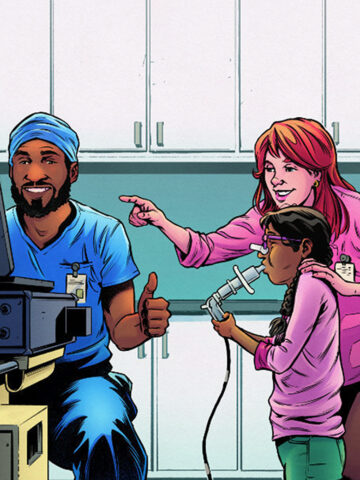The study of rheumatology covers a large swath of medicine that deals with inflammation of bones, muscles, joints and internal organs. It includes more than 100 diseases, including arthritis and lupus.
To help doctors keep focused on the diagnosis and treatment of this complicated area of medicine, Dr. Andrew Shulman, medical director of rheumatology at CHOC, offered a talk on the top five things pediatricians need to know about rheumatologic diseases.

The list featured the following topics:
- How can we approach the evaluation of musculoskeletal pain?
- What is arthritis? What is the presentation of juvenile arthritis?
- How can laboratory tests effectively be used to assess for systemic inflammation or autoimmunity?
- When can we suspect a diagnosis of systemic lupus erythematosus or juvenile dermatomyositis?
- What is pain amplification syndrome?
How can we approach the evaluation of musculoskeletal pain?
How a pediatrician approaches an evaluation of musculoskeletal pain is vital first step for a successful outcome.
“The history and physical exam skills of the clinician are really rewarded here in getting us on the right direction toward the diagnosis,” he says.
The history and exam take a lot of time, so it’s important to ask the right questions, such as learning about the duration, location of the pain, and its relation to activity and exercise. Is there stiffness? Discoloration? How long has the patient been experiencing the pain? When does it occur?
“I like to ask questions like what makes it better? What makes it worse?” he says. “The classic presentation of juvenile arthritis would be swelling and stiffness are worse in the morning and gets better with movement and activity.”
But other causes of pain, such as overuse or can occur in the evening.
What is arthritis? What is the presentation of juvenile arthritis?
Juvenile arthritis can often be misdiagnosed, says Dr. Shulman.
“The first misconception would be that joint pain is arthritis,” he says. “That is certainly not the case. … There are many potential diagnoses for joint pain.”
Indeed, Dr. Shulman said that arthritis can be compared to a cough in that it can be more of a symptom than a diagnosis. It is the job of a clinician to delve deeper into the cause of the pain. Another misconception is that lab tests are adequate for determining if a patient has arthritis.
“A patient can have entirely normal laboratory tests, but still have significant arthritis,” he says. “We should think of labs as a tool to characterize and give more information about arthritis, but it’s really a history, physical exam … that are going to really diagnose arthritis”
Dr. Shulman then said that a particularly problematic misconception is that arthritis is an ailment of the elderly. In fact, he noted the Arthritis Foundation indicated that more children in the United States have arthritis than juvenile diabetes, cystic fibrosis and muscular dystrophy combined.
The best way to diagnose arthritis is through a detailed history, physical examination, as well as lab and imaging data, says Dr. Shulman.
How can laboratory tests effectively be used to assess for systemic inflammation or autoimmunity?
Pediatricians should know the importance of running a series of standard laboratory tests. Only after the routine tests are given, does Dr. Shulman suggest performing more specific tests.
“More often than not that’s really going to give us a good perspective on systemic inflammation and a pretty broad sense of the overall health for that patient,” he says.
But he also cautions that routine tests, such as a complete blood count and erythrocyte sedimentation rate — as well as antibody markers — don’t rule out the patient having arthritis. He discussed the value of autoimmune antibody tests and cautioned that have limited value by poor specificity.
Moving on to the diagnosis of systematic lupus erythematosus and juvenile dermatomyositis, which Dr. Shulman noted are two of the more common conditions that need to be diagnosed in a timely manner. Lupus tends to appear in school-age children, affects females far more than males. More severe cases are also seen in Latina and Asian populations. It affects small joints in the hand, wrists shoulders, knees, ankles and elbows.
“A typical patient is going to be an adolescent teenage girl with a rash, fever, photosensitivity, weight loss and fatigue,” he says.
When can we suspect a diagnosis of systemic lupus erythematosus or juvenile dermatomyositis?
Dr. Shulman says he pays special attention to looking for lesions in a patient’s mouth as a sign of lupus.
“A lot of the time, the residents in the hospital will see me be really interested to get a look at the roofs of the mouth in patients that we’re working with in the hospital that may have lupus,” he says. “You can also see an ulcer there on the tongue and a rash on a photosensitive distribution on the anterior chest.”
Juvenile dermatomyositis is an autoimmune inflammatory condition involving skin, muscles and joints. It affects from 1 million to 5 million children a year. Symptoms include a rash, weakness and fatigue.
What is pain amplification syndrome?
Pain amplification syndrome is a chronic musculoskeletal pain condition due to dysregulation of the nervous system’s threshold for pain detection. Its triggers include infections, injury, sleep disruption and psychological stress. Symptoms include fatigue, headache, abdominal pain, sleep disturbance, anxiety and depression. It could be more prevalent than currently understood.
“I think that pain amplification syndrome is a very common cause of pain in the pediatric age group, and perhaps more common than juvenile arthritis,” Dr. Shulman says. “Unfortunately, we don’t have great incidence or demography information because I think of pain amplification syndrome as being something that’s very much still on the frontier of medicine and it has been difficult to study.”
Treatment is multidisciplinary and includes aerobic exercise, massage and acupuncture, sleep therapy and psychological therapies, such as anxiety management and relaxation techniques.
Refer a patient to Rheumatology at CHOC




